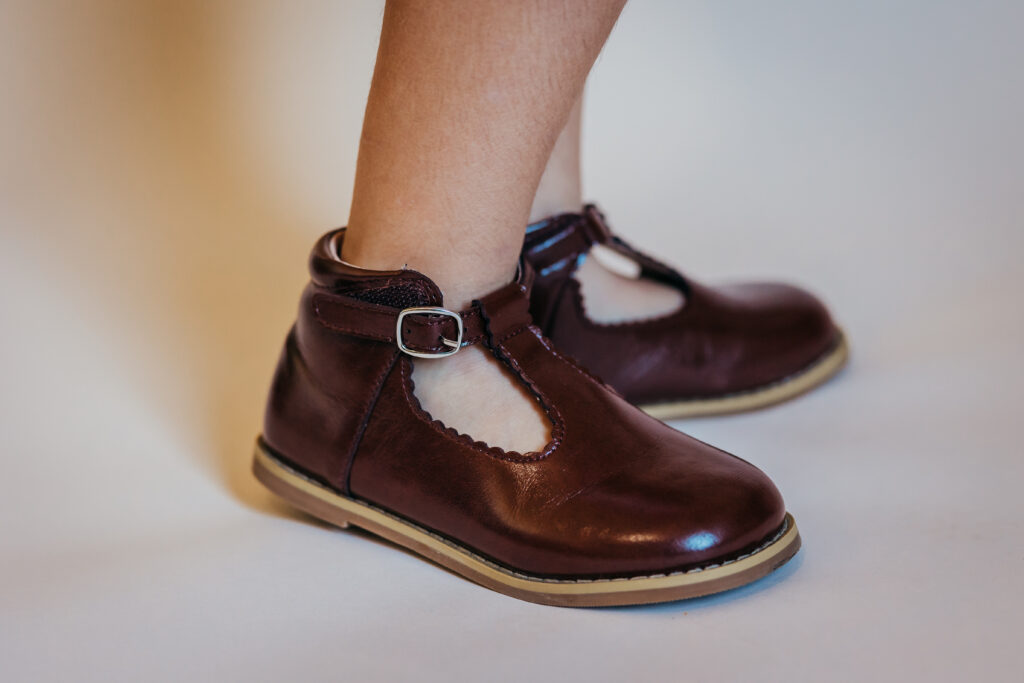Why choose our wide toe shoes
Foot Health



The sole of the foot is made up of many complex bones, joints, muscles and tendons. The most important of these is the arch of the foot, which is made up of the tarsal and metatarsal bones and provides the support and flexibility that enables us to stand, walk and run.
Most of the information in the brain about movement comes from the nerve endings in the feet, making it important to balance and coordinate the feet and the perception of the ground with the feet. This is especially important for young children learning to walk.
Bones are initially cartilage and all the components of the foot are not fully developed until the child reaches about 18 years of age. The arch also develops later in childhood, usually between the ages of 2 and 5, but sometimes later. It is not a structural part of the foot, but a muscle that needs to be utilized and exercised to develop. This is why a toddler’s foot can look very flat and can often look rolled or turned in.

Children’s foot health is vital to growth. The arch is an important structure in the foot that helps children maintain balance while walking, running and jumping. Two common problems that affect foot health are flat feet and pronation.
Flat feet are defined as having a low arch height that causes the inside of the foot to touch the ground. Physiological flat feet are common in children and usually normalize with age. However, persistent flat feet can lead to foot pain, fatigue and gait abnormalities.
Internal rotation, in which the foot rotates excessively inward while walking or running, may lead to overloading of the inside of the foot, causing problems such as flat feet, foot pain and gait abnormalities.
To prevent and manage flat feet and internal rotation, parents can take the following steps:
1、Choose appropriate shoes that provide adequate support and cushioning.
2、Perform targeted exercises to strengthen the muscles and ligaments of the feet.
3、Conduct regular foot examinations to understand the development of the foot arch.
4、Use arch cushions or customized insoles under professional guidance.

Barefoot Shoes are shoes designed to mimic the sensation of walking barefoot and are intended to provide an experience as close as possible to the natural walking state. Characteristics of these shoes include the following:
Sufficient Flexibility:
Barefoot shoes usually have excellent flexibility and stretch, allowing the foot to move freely and mimicking the natural movement of being barefoot.
Thin sole design:
Barefoot shoes have very thin soles, which minimizes the isolation of the sole from the sensation of the ground and allows the wearer to better perceive the ground.
Zero or low drop: Many barefoot shoes are designed with a zero drop (i.e., the heel and forefoot are the same height) or low drop, which reduces the pressure on the feet and legs when walking and promotes a natural gait.
Loose toe:
Barefoot shoes are designed with a loose toe to provide enough room for the toes to spread naturally, which contributes to the health and comfort of the feet.
Lightweight:
Barefoot shoes are usually very lightweight, reducing the burden when walking and making the wearer feel more relaxed.
The popularity of barefoot shoes is partly due to the fact that they fit the idea of natural movement and healthy living. They are believed to help improve posture, reduce stress on the feet and legs, strengthen foot muscles, and improve balance and agility. However, due to the thin-soled design of barefoot shoes, they may not be suitable for all environments and activities, especially in situations where extra protection and support is needed.So choose the right shoe for your environment.
Flexible
Barefoot wide-toe shoes provide more room for your child’s toes to flex in all directions to reflect the natural movement of the foot, which helps to enhance strength, agility and sensory feedback for foot growth.
Wide Toe Box
Children’s feet are shaped differently than adults, in a triangular shape, requiring shoes with a larger toe area. A good toddler shoe should not just be a scaled down version of an adult shoe, but should have a spacious toe box that allows the toes to twist and spread freely. The opening of the shoe should also be wide enough for the foot to slide in easily and avoid squeezing the toes.
Light and thin
We focus on minimizing the weight of our shoes. The thickness of our different types of barefoot soles is 3-3.5mm.
Zero Drop
The heel and forefoot are at the same level, promoting natural posture, encouraging a healthy gait, and strengthening the core muscles children use to maintain balance.
Changing to Barefoot Shoes Precautions
Parents should pay attention to the following points when switching children from structured shoes to barefoot shoes:
With these precautions, your child can safely enjoy the natural walking experience of barefoot shoes.


A basic guide to shoes and foot care
Phone:
86-15602437142
E-mail:sandy@chaosbebe.com
Company Address:No.6, Lane 3, Xin Da Keng, Long Dong, Long Gang, Shen Zhen, China
pening Hours:
Monday – Friday
09:00 am – 09:00 pm
Saturday – Sunday – Closed
We will contact you within 1 working day, please pay attention to the email with the suffix “@chaosbebe.com”.